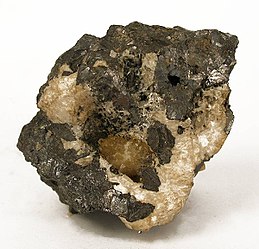
Murdochite is a mineral combining lead and copper oxides with the chemical formula PbCu
6O
8−x(Cl,Br)
2x (x ≤ 0.5).

Phosgenite is a rare mineral consisting of lead carbonate chloride, (PbCl)2CO3. The tetragonal crystals are prismatic or tabular in habit: they are usually colorless and transparent, and have a brilliant adamantine lustre. Sometimes the crystals have a curious helical twist about the tetrad or principal axis. The hardness is 3 and the specific gravity 6.3. The mineral is rather sectile, and consequently was earlier known as corneous lead, (German Hornblei).

Bolehill is an area of Wirksworth, Derbyshire, England. It is located in the north of the town and has connections to the lead mining. Bolehill is adjacent to Black Rocks, a local landmark and a short walk from the High Peak Trail at Middleton incline.

John Mawe was a British mineralogist who became known for his practical approach to the discipline.
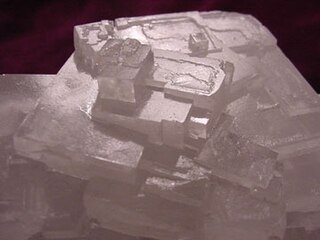
Halide minerals are those minerals with a dominant halide anion. Complex halide minerals may also have polyatomic anions.

Duftite is a relatively common arsenate mineral with the formula CuPb(AsO4)(OH), related to conichalcite. It is green and often forms botryoidal aggregates. It is a member of the adelite-descloizite Group, Conichalcite-Duftite Series. Duftite and conichalcite specimens from Tsumeb are commonly zoned in color and composition. Microprobe analyses and X-ray powder-diffraction studies indicate extensive substitution of Zn for Cu, and Ca for Pb in the duftite structure. This indicates a solid solution among conichalcite, CaCu(AsO4 )(OH), austinite, CaZn(AsO4)(OH) and duftite PbCu(AsO4)(OH), all of them belonging to the adelite group of arsenates. It was named after Mining Councilor G Duft, Director of the Otavi Mine and Railroad Company, Tsumeb, Namibia. The type locality is the Tsumeb Mine, Tsumeb, Otjikoto Region, Namibia.
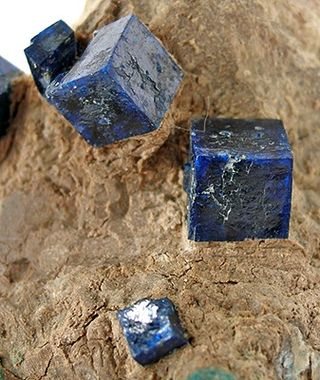
Boleite is a complex halide mineral with formula: KPb26Ag9Cu24(OH)48Cl62. It was first described in 1891 as an oxychloride mineral. It is an isometric mineral which forms in deep-blue cubes. There are numerous minerals related to boleite, such as pseudoboleite, cumengite, and diaboleite, and these all have the same complex crystal structure. They all contain bright-blue cubic forms and are formed in altered zones of lead and copper deposits, produced during the reaction of chloride bearing solutions with primary sulfide minerals.

Bismuth oxychloride is an inorganic compound of bismuth with the formula BiOCl. It is a lustrous white solid used since antiquity, notably in ancient Egypt. Light wave interference from its plate-like structure gives a pearly iridescent light reflectivity similar to nacre. Previously, until the last decade of the twentieth century, bismuth oxochloride was known as bismuthyl chloride. It is also known as pigment pearl white.

Curite is a rare mineral with the chemical composition Pb3[(UO2)4|O4|(OH)3]2·2 H2O. It is therefore a hydrated lead uranyl oxide, which forms red needles or orange, massive aggregates.

Laurionite is a lead halide mineral. It forms colorless to white crystals in the orthorhombic crystal system and is dimorphous with paralaurionite, both members of the matlockite group.

Paralaurionite is a colorless mineral consisting of a basic lead chloride PbCl(OH) that is dimorphous with laurionite. It is a member of the matlockite group. The name is derived from para-, the Greek for "near", and laurionite, because of its polymorphic relationship to it. Bright, yellow tips of thorikosite can form on paralaurionite crystals and paralaurionite may also be intergrown with mendipite.
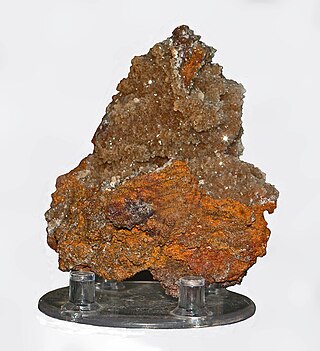
Tarbuttite is a rare phosphate mineral with formula Zn2(PO4)(OH). It was discovered in 1907 in what is now Zambia and named for Percy Coventry Tarbutt.
Lead oxychlorides are halide compounds of lead with the general formula PbClO(H).

Diaboleite is a blue-colored mineral with formula Pb2CuCl2(OH)4. It was discovered in England in 1923 and named diaboleite, from the Greek word διά and boleite, meaning "distinct from boleite". The mineral has since been found in a number of countries.
Daubréeite is a rare bismuth oxohalide mineral with formula BiO(OH,Cl). It is a creamy-white to yellow-brown, soft, earthy clay–like mineral which crystallizes in the tetragonal crystal system. It is a member of the matlockite group.
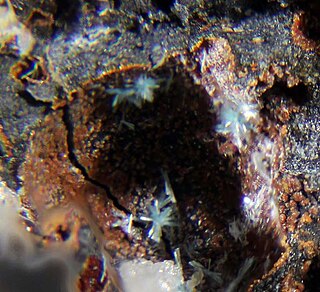
Mammothite is a mineral found in the Mammoth mine in Tiger, Arizona and also in Laurium, Attika, Greece. This mineral was named in 1985 by Donald R. Peacor, Pete J. Dunn, G. Schnorrer-Köhler, and Richard A. Bideaux, for the Mammoth vein (one of the two main veins in the mine) and the town of Mammoth, Arizona, which was named for the mine. The mammothite that is found in Arizona exist as euhedral crystals imbedded in micro granular, white colored anglesite with a saccharoidal texture. The associated minerals include phosgenite, wulfenite, leadhillite and caledonite. In Greece, the mammothite exists as small euhedral crystals and also as microscopic rock cavities lined with projecting crystals within the slags. The associated minerals here are cerussite, phosgenite and matlockite. The ideal chemical formula for mammothite is Pb6Cu4AlSb5+O2(OH)16Cl4(SO4)2.
Zhangpeishanite is a mineral named after Zhang Peishan, a Chinese mineralogist at the Institute of Geology of the Chinese Academy of Sciences, in recognition of his contributions to studying the mineralogy Bayan Obo deposit, where the mineral is mined. The Bayan Obo deposit is also known for being a world class deposit. The mineral got approved by the IMA in 2006 but was published two years after its approval. The mineral consists of barium chloride fluoride.

Penfieldite is a rare lead hydroxychloride mineral from the class of halides. It was named after Samuel Lewis Penfield. It has been a valid species before the founding of IMA, and was first published in 1892. It had been grandfathered, meaning the name penfieldite is still believed to refer to a valid species. When it was first described by Genth in 1892 from Laurion, Greece, the mineral had the formula of Pb3Cl4O.
Belloite is a Halide mineral first discovered in the Rio Tinto Mine in Sierra Gorda, Antofagasta, Chile in 1998. Belloite has the ideal chemical formula of Cu(OH)Cl. The mineral has been approved by the Commission on New Minerals and Mineral Names, IMA, to be named belloite, after Andrés de Jesús María y José Bello López, the founder of the Universidad de Chile. Samples of belloite are preserved in the collection of the Mineralogical Museum in Hamburg, Germany.
